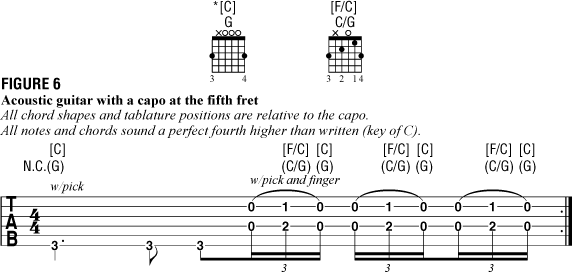Lesson: Using Pull-offs With Open Chords

In a previous lesson we talked about hammer-ons. Now we’ll build on that discussion and explore another playing device that can be used to spice up a strumming or picking pattern, the pull-off.
As you recall, to play a hammer-on you pick a string by firmly tapping, or “hammering,” one of your fretting fingers onto the fretboard without picking it again, as demonstrated in Figure 1. The pull-off may be though of as the opposite of the hammer-on; in this case, you pick a fretted note and then lift the fretting finger to sound a lower note on the same string, as shown in Figure 2. Both techniques are indicated in sheet music by a curved line – known as a slur – arcing from the first note to the second.


Pull-offs are a bit harder to pull off, so to speak, than hammer-ons, since in order to keep the string vibrating when executing a pull-off you must pick the string with your fretting hand as you let go of it, pulling slightly in toward your palm just before you release it. And if you’re pulling off to a fretted note you need to finger that note in advance, before pulling off. Otherwise, the string will be muted and the note you’re pulling off to will be inaudible.
Figure 3 demonstrates how a pull-off can be used to embellish an open D chord via a Dsus4-to-D change. After strumming the Dsus4 chord, allow the notes to ring by maintaining the chord position with your fretting hand. Then pull your pinkie off the G note on the high E strong to sound the F# at the second fret. Remember that you must “pre-fret” the F# note with your middle finger before initiating the pull-off.

Figure 4 is an example of how pull-offs can be used to transform a strummed four-chord progression into a catchy, melodic phrase. Be sure to use the strumming strokes indicated above the tablature and to pre-fret the D,A,C and G chord shapes before pulling off.

Pull-offs are particularly effective when used in conjunction with hammer-ons, as demonstrated in Figure 5. In this example, open Dm and C chord shapes are arpeggiated (played as single notes) and embellished with sus2 hammer-ons and sus4 pull-offs. Notice the use of quick hammer-on/pull-off combinations in each bar.

A classic instance of the effective use of hammer-ons and pull-offs within an open chord shape may be found in Simon and Garfunkel’s “I Am a Rock.” Figure 6 illustrates a sweet-sounding lick similar to that song. Simon employs hybrid picking (pick and finger technique) to affect quick hammer-on/pull-off combinations on two strings. Be sure to execute each pair of hammer-ons and pull-offs as tightly as possible, moving your fretting hand’s middle and index fingers in lock-step fashion. Remember to pull each finger in toward your palm as you release it. Practice makes perfect!
All the latest guitar news, interviews, lessons, reviews, deals and more, direct to your inbox!

The examples depicted in this and the column of hammer-ons should give you a sense of how hammer-ons and pull-offs are used in other tunes. Ideally, they’ll inspire you to experiment and create your embellishments. Who knows? That one irresistible hook you’ve been looking for may be just a hammer-on or pull-off away.
